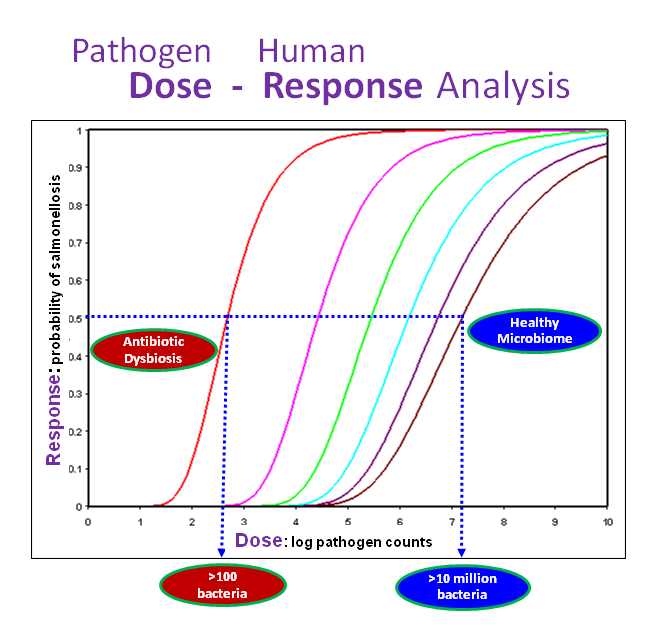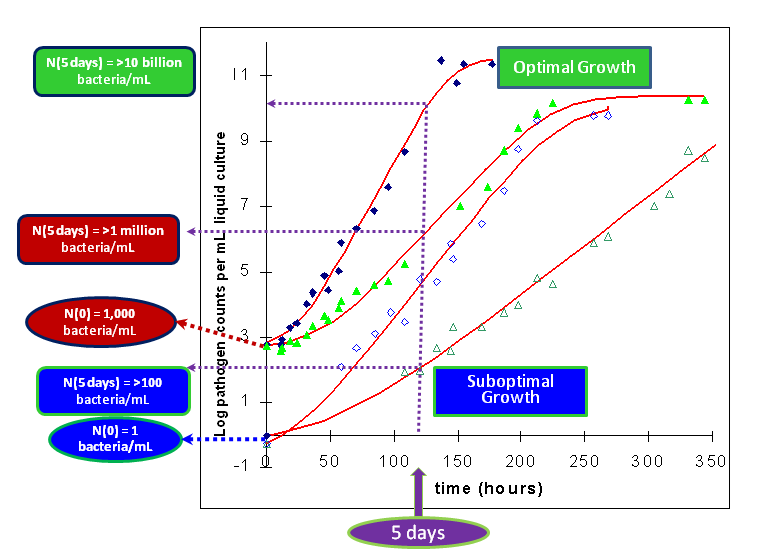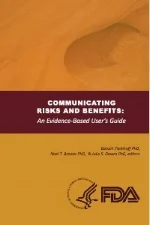Expert Capabilities in Multi-Disciplinary Risk Analysis
- Reviews and evaluates scientific evidence for health benefits and risks of illness from exposures to microbes in the environment (air, buildings, soil, water) and in foods from farm to table
- Compiles documentation for setting safe doses of pathogens unlikely to cause illness in healthy people
- Prepares scientific support for assessing the limits of microbial growth including microbial ecology, particularly competition with natural microbiota in the environment and foods
- Delivers lectures and presentations on benefits and risks of microbes in academic, professional, and public webinar environments
- Provides critical review of scientific studies, reports, and risk assessments
assess dose-response relationships
The dose of pathogens is vitally important to predicting whether or not illness will develop and how severe the illness will become. Presence of a pathogen in air, food, and water is insufficient evidence to predict risk. CSC cultivates connections with the dose-response modeling community through the Society for Risk Analysis (SRA)/Dose-Response Specialty Group to offer clients valid evidence-based perspectives on doses of pathogens that are safe and those that are likely to cause illness, even when supporting data are sparse and alternative assumptions are theoretical.
As dose of microbes increase, the likelihood of responses (illness for pathogens, benefit for probiotics) increase.
Predicting human responses to doses of microbes in food or the environment requires knowledge of pathogens AND the normal gut and food microbes (the microbiota) that compete with pathogens and prevent illness. Ingestion of a single pathogen cell is extremely unlikely to cause illness in healthy humans due to our innate defenses, including the protective microbiota. As demonstrated in many clinical trials with human volunteers, increasing administered doses of pathogens (e.g., hundreds, thousands, or millions of pathogens) can overwhelm innate defenses, and illness and severe illness are more likely.
People and laboratory animals with healthy gut microbiota can ingest significantly more pathogens before becoming ill than those with their microbiota disrupted by antibiotics or underlying diseases. Dose-response data from studies conducted in mice and other laboratory animals have both disadvantages and advantages as the basis for assessing risk of illness.
The dire disadvantage for data from animal experiments is that often even experienced risk assessment teams may extrapolate from mice and other animals to humans based on infeasible assumptions, without adequate considerations of alternative assumptions.
When a risk estimate hinges on conservative assumptions about dose-response relationships (e.g., non-threshold linear low-dose models), risk is likely overestimated and uncertainty poorly characterized. Overconfidence in poor data and assumptions can have unintended long-term consequences. For example, updates of risk and uncertainty estimates are less likely to be undertaken even when data from controlled experiments become available. These pitfalls can be avoided by considering knowledge and data on the microbial ecology of pathogens in gut ecosystems more systematically in the initial phases of assessment.
For pathogens with known underlying mechanisms for causing human illness, use of animal models is an advantage because researchers can control more variables in animal studies than in human studies. Also, models based on human data can be adjusted for animal data when observations in humans reflect limited conditions (see figure below on salmonellosis).
Pathogen dose influences human response. Half of human volunteers with healthy microbiota (blue oval) did not get salmonellosis until ingesting ten million pathogens, while humans with antibiotic disruption (red oval) are likely to get ill ingesting only 100 pathogens. From Coleman et al., 2017b.
assess exposure, Predictive Microbiology
Exposure to pathogens is unlikely to lead to illness unless the pathogen is able to grow to levels that overwhelm our innate immune defenses. Predicting bacterial growth is simple for pure cultures under defined laboratory conditions but more complicated when considering the food and gut microbiota.
Dose matters not just for dose-response assessment, but also for selecting and interpreting the impact of the initial dose administered in challenge experiments for use in predictive microbiology. Optimal growth of the pathogen E. coli O157:H7 (green text boxes in figure below) typically does not occur in foods with intact microbiota; suboptimal growth from low numbers of pathogens is more typical of foods. Growth in a food contaminated by low pathogen numbers (blue text boxes) and refrigerated for 5 days could be overpredicted by more than 4 orders of magnitude if the more optimal growth model (red text boxes) was selected for estimating potential risk for consumers. CSC serves as a trusted advisor who provides both scientific support for assessing exposure and practical training for clients who need to consider alternative assumptions where data are incomplete, ambiguous, or conflicting in order to provide unbiased, objective estimates of risk and uncertainty.
Low numbers of pathogens grow slower and to lower levels (line with blue annotations) than high numbers of pathogens (curve with red annotations). From Coleman et al., 2003a.
Nearly a trillion lactic acid bacteria per gram yogurt suppress growth of more than 10 million E. coli O157:H7 (see figure below). Suppression of low pathogen counts more typical of well controlled food processes would be even quicker. Growth of this and many other pathogens in non-sterile food (or in the human gut colonized by 14 trillion potentially beneficial bacteria) is extremely unlikely, especially at refrigeration temperatures. The conditions limiting pathogen growth, including temperature, initial numbers, and natural competition of the food microbiota, determine the model that best applies for clients concerned about pathogen growth in foods and in or on the human body.
Data on competition of lactic acid bacteria with pathogen obtained from ComBase (http://www.combase.cc/index.php/, YN60k_2_16).
review, analysis,and program support
CSC specializes in providing reviews and analysis of the published literature to assist decision makers charged with identifying, estimating, and managing risks caused by microbes in foods from farm-to-table (production, processing, and consumption) and in the environment (air, buildings, soil, and water).
Our knowledge of microbial systems has contributed to development of methodological frameworks for applying often fragmented knowledge of pathogens for decision makers in multiple government agencies in the US and around the world.
After 911 and the anthrax attacks via the US mail system, CSC contributed to preparedness planning to minimize illnesses and maximize effectiveness of responses for future biothreat attacks. CSC supported development of methodology for site-specific assessment, setting safe biological exposure levels, and exercises for community responders to bioterrorism attacks.
CSC teams developed risk models and evaluated software tools for microbial risk assessments of foodborne disease and biothreat agents.
Present on Risk analysis/assessment
So much of the treatment of risk in the media is based predominantly on emotionality, excluding trust and fairness, other essential elements of risk communication necessary to support evidence-based policy and rational public discourse. CSC prepares and delivers objective lectures, presentations, and webinars to diverse audiences who seek to understand complex scientific evidence supporting estimates of risks and benefits for microbes present in the environment and foods.
Our clients value CSC's knowledge and ability to separate scientific facts from beliefs or myths about risk and health. Public engagement processes are essential for moving from ineffective policies based on fear, panic, and misinformation to rational and fair policies that are updated with 21st century science and freedom of choice for consumers. Download the free report by the National Academy of Sciences below describing cycles of analysis and deliberation.
Many CSC assessments, published analyses, and presentations incorporate unique insights into significant impacts of microbial ecology for environmental and food chain exposures to pathogens. Scenarios considered include intentional biothreat attacks and natural and built environments, particularly for farm-to-fork systems.
CSC invests significant time and energy to continue to raise challenges to use of outdated conservative assumptions that overestimate risk (e.g., non-threshold low-dose linear models for dose-response), as well as underestimate uncertainty and poorly reflect pathogen interactions in complex biological systems like animal and human gastrointestinal tracts. The CSC motivation is the need for objective evidence-based policies that consumers around the world can trust to support healthy humans and sustainable environments.
expert testimony on microbial risk/benefit
Many governmental organizations consider the presence of potential pathogens as risky, regardless of the level of the pathogen or the state of health of the host. Yet, the first decade of research since initiation of the Human Microbiome Project (https://www.hmpdacc.org/) reveals many incorrect assumptions about microbial systems, focused on fear of microbes as germs that will kill us. CSC provides evidence-based testimony on microbial benefits and risks that challenges policies based on outdated 20th century science or germophobia.
Many 21st century studies now demonstrate that microbes contribute to our health, and our natural microbiota provide innate protection from many pathogens present in foods and the environment. Key topics that defensible microbial risk analyses must address if claiming use of best available science include: 1) the human superorganism, Homo sapiens plus dense, diverse natural microbial partners, the microbiota; and 2) colonization resistance, protection against communicable and non-communicable diseases by healthy superorganisms (with protective microbiota intact).
These concepts from microbial ecology and medical microbiology were rarely if ever introduced in discussions of microbial risk before development of culture-independent methods for identifying and enumerating strains in dense, diverse microbial ecosystems from coral to the human gut. Before evidence-based policies can be developed for pathogens present in foods and the environment, more structured discourse is needed on both benefits and risks (download report below by Fischoff et al., 2011). Further, case studies are needed that apply the methodology described in the report below to microbes now that 21st century science demonstrates both benefits and risks to human consumers, particularly to consumers of raw (fresh unprocessed) foods. CSC assists clients with processes and products that respect beliefs and assumptions, but frame policy decisions on the evidence behind beliefs and assumptions about benefits and risks.






